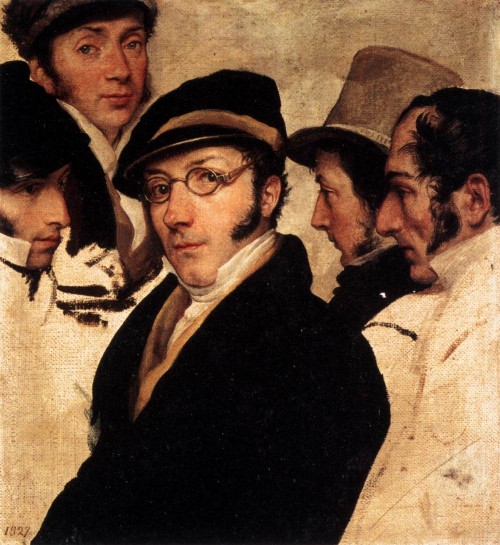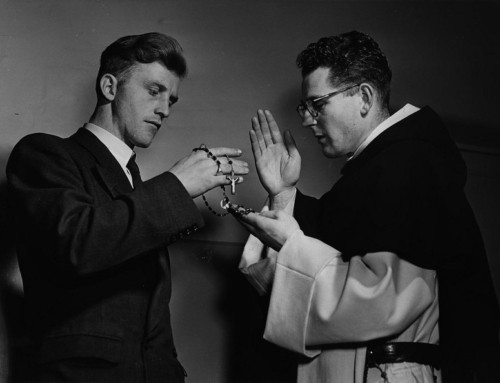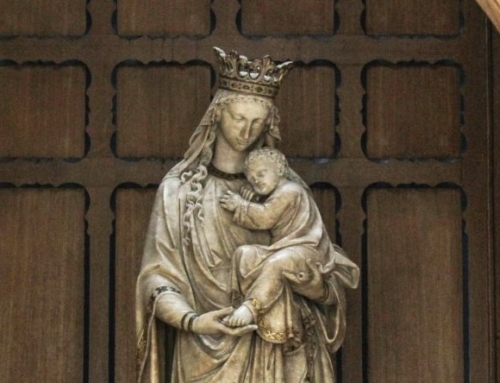Where is the Life we have lost in living? —T. S. Eliot
There is something dissatisfying about walking on laminate wood floors. Even if they look good, they feel fake. They crinkle rather than creak. They bear a sad uniformity not found in nature. Made from chemicals, sawdust, ink, and who knows what else, they are designed to look like wood. There is a familiar scene in many “house hunter” shows where a young couple is looking to buy an old house. They move through the rooms lifting up the wall-to-wall 1970s shag carpet looking for original hardwood floors like they are looking for a treasure. No one pulls up rugs hoping to discover laminate floors. Why? Laminate floors are not what they purport to be. They are not the real thing. They are a simulacrum. But we want the real thing. When something is true throughout, when the surface reflects the interior, when it is what it purports to be, it is authentic.
In this article, I intend to elucidate a philosophical definition of authenticity. In this, I am especially indebted to Charles Taylor and the argument he makes in The Ethics of Authenticity. The value of authenticity is one that we pursue not just in our floors. On the human level, it becomes a moral ideal. It is a goal of human striving. Authenticity demands that we know our principles and live according to them. But the ideal only needs to be stated to see how it can go wrong, for if everyone is their own arbiter of authenticity, then the ideal quickly degrades into individualism. So the meaning cannot be purely self-generated. Rather, authenticity must be seen as an ideal received from and lived out within a community. This background of significance gives meaning to the ideal and helps prevent it from slipping into individualism.
The Loose Individual—A Failure to Authenticate
In a modern democratic society, class and place within a hierarchy do not account for differences among people as they did in pre-modern social contexts. In a more egalitarian milieu, authenticity becomes a way to achieve true self-identity and to set oneself apart from fellow men. But in the pursuit of this ideal, there is also the danger of sliding into egoism and selfishness.
Individualism and authenticity are not equivalent ideas even though they are often conflated and the latter is used to justify the former. The authentic person is true to himself, while the individualistic person lives just for himself. One reason for this confusion is that when authenticity goes wrong, it tends to resemble individualism. Taylor refers to individualism as a “malaise” that clouds authenticity. So we will begin by examining this malaise in order to lift the shadow it casts on the ideal. I will bring out three interconnected features of individualism: it narrows life, loosens the individual from communal bonds, and tends towards moral relativism.
An effect of individualism is the narrowing of human life. “Narrow” in this case refers to a myopic focus on solitary projects to the exclusion of concerns that emanate from beyond the self. Transcendent values are lost in this shrunken worldview. And as we will see, a narrow scope for the individual leads to disorder in the social sphere.
A good literary instance of this narrowness can be found in Walker Percy’s The Moviegoer. The narrator and semi-protagonist Binx Bolling refers to his life as a battle against the “malaise.” When you are stuck in it, “the world is lost to you, the world and the people in it.” It is not that Binx does not spend time with other people. He has coworkers and clients, visits family members, and pursues romantic flings with women. It is, however, the ephemeral approach he takes to these relationships which disconnects him from others. And he takes this approach because his scope is narrow. Binx Bolling is a successful and acclaimed literary character because he embodies a modern type we are familiar with: the loose individual. This is particularly evident in his relationships with women. Binx is enthralled by the supposed freedom of the chase. But in fact, he instrumentalizes these relationships. He sees women as means to his personal end of self-fulfillment. The Moviegoer finishes, however, with Binx marrying Kate—someone he has been romantically involved with. In the end, it is actually an ordered relationship that saves Binx. He has moved from living a narrow individualism to recognizing and abiding by a higher order, namely, marriage as the proper end of a romantic relationship.
We can also view individualism from a group perspective. Narrowness of life and social fragmentation are flip sides of the same coin. The sociologist Robert Nisbet has correlated the breakdown of community with the rise of individualism. In The Present Age, he references a conversation between Dr. Johnson and Boswell in which Johnson refers to a man who “hangs loose upon society.” What Johnson was describing—or rather whom he was describing—was someone who flitted about society without moral grounding. From this conversation, Nisbet derives the social category of “the loose individual.” The outlier in Johnson’s time has become the standard in our own. We have moved from a quaint conversation regarding a social anomaly to a diagnosis of mass anomie. With many others like himself and plenty of room to roam, the loose individual lives an atomized and untethered life. He is loose from marriage, family, school, church, and local voluntary associations. Having withdrawn from civil society, he becomes overly concerned with his own interests.
Alexis de Tocqueville, a prescient commentator on American polity and culture, observed that without a strong civil society and the moral impulse to maintain it, individuals in a democratic society will recede from community and turn towards their own petty pleasures. The loose individual is a fulfillment in our day of Tocqueville’s observation in the early nineteenth century. Communities fragment as members depart. The well-established fact of social fragmentation is merely the proliferation of the loose individual.
The malaise of individualism narrows scope while it loosens the individual from traditional community. The distortion of authenticity also leads to moral relativism, as it tends to reduce life to personal preference. Transcendent values lose importance and fade away. The self becomes all-encompassing and begins to fill the entire horizon of meaning in life. But this horizon is in fact quite small. With moral relativism, the good life is reduced to what any individual happens to value. Judgments on objective moral values are banished, for this would amount to dictating some particular vision of self-fulfillment. One does not want to appear intolerant of “liberty” as it is (mis)construed. An objective framework becomes difficult to find and appeal to.
Relativism is a feature of individualism which particularly clouds the ideal of authenticity. In fact, many invoke the ideal to justify a morally relativistic life. That is, they may be “doing their own thing” without reference to any standard yet defend their way of life by claiming authenticity. “I can’t help it. I’m being authentic. That’s who I am.” But this confuses the degraded form of the ideal with the ideal itself: individualism with authenticity. Someone who lives a self-indulgent life has not achieved authenticity. The latter implies a deep congruence between one’s way of life and moral principles. Self-indulgence implies the opposite. This identification also reveals that, in fact, authenticity is an ideal, or else it would not be used as cover for an egoistic way of life. No one in the culture of relativism invokes egoism as an ideal. They invoke authenticity. But the abrogation of the standard does not falsify it. It confirms it. Just as any deviation from the law, no matter how frequent, does not incriminate the law, so relativism does not lessen authenticity. As such, we must now investigate how authenticity is an ideal and thus varies from the individualism described above.
An Ideal in the Ruins
Is pessimism regarding our individualistic age our only option? Must we be universally critical of the contemporary culture of self-fulfillment? Taylor suggests we should resist such a stance. Pessimism here ignores a powerful moral ideal. We do well to criticize and resist individualism, but we must not throw out the ideal with its degraded form.
What are the sources for developing an understanding of authenticity? Certainly there is a connection with ancient philosophy, as with the Delphic Oracle and its injunction to self-knowledge. We see a source in Socrates, who was constantly calling the integrity of the duplicitous Sophists into question. But authenticity becomes a moral ideal in the modern period. It is especially associated with, though not identical to, the subjective turn of the Enlightenment. With the thinkers and theories of that time, there is a movement away from authority and tradition towards the individual. We find obvious examples in Descartes with his solitary cogito method, Kant and his autonomy/heteronomy distinction, and Rousseau with the essential vs. peripheral self. In this subjective turn, we moved away from pre-modern conceptions of identity. Before the Enlightenment, man saw and measured himself according to his place in a hierarchical society and what Taylor refers to as the “Great Chain of Being.” The self was understood as holding a rational place of honor in the cosmos. Differences between men were not accounted for based on some conception of personal fulfillment.
Philosopher Johann Herder offers a definition of authenticity that accords with our modern conception. According to Herder, we all have an original way of being ourselves. We each have our own “measure,” and to be authentic is to express this unique “measure.” Modern man sees life in these terms. Being in touch with self and then being true to oneself become paramount to living a successful life. To ignore or miss this originality would be to miss the meaning of my life. Very often there are both internal and external influences that cloud this internal exchange. One must listen to his interior voice and respond appropriately. Following Herder’s account, Taylor emphasizes that authenticity is a moral ideal. It is a standard that we feel drawn to—an end of human striving. We recognize it as a good to pursue, and feel a call to live according to it. We want our lives to be true and to own up to who we really are.
The ideal is not just thinly veiled relativism. It maintains its objectivity for a few reasons. Firstly, we can appeal to authenticity as a standard we feel called to pursue. We feel drawn to it precisely as an ideal. So it is not mere egoism. People do not feel called to live a narcissistic life. More often they slide into it. It is not held out as a life goal to be pursued, whereas authenticity is. We desire it as something positive. Secondly, by it we can judge higher or lower ways of living. It provides a framework to judge a successful life. We can investigate our way of life and determine if we are striving for this ideal. It does not self-destruct like moral relativism. According to the latter, any conception of self-fulfillment would be as good as another. But this provides no way to adjudicate between good and bad. If every way is equally good then it is also equally meaningless. But authenticity requires that some ways of life will qualify as authentic and others will not. That authenticity is an ideal also reveals that it is not a private pursuit. As we will see, we must have recourse to transcendent values to determine the content of an authentic life. That is, the ideal must be publicly available. Community provides these values and secures the objectivity of the ideal. We will come back to this idea in the next section.
Yves Simon said that the only way to be yourself is to not be someone else. This sentiment affirms how life cannot be a vicarious project. We need to know principles in a reflexive way and live according to them. Though these principles may emanate from beyond the self, they have to be appropriated thoroughly according to this ideal. This implies the feature of originality. Everyone has an original way of being human. We have a unique and unrepeatable view of the world that we strive to discover and express.
Every man has an original view of the world, but it is not a view from nowhere. We do not pursue conceptions of self-fulfillment in a vacuum. This ideal requires that the internal voice accords with an external horizon of significance. And this horizon necessarily includes important questions. In a word, it amounts to community. The ideal must be seen and lived in reference to a community so that it does not degrade into relativism.
The Horizon of Community
Authenticity presupposes a horizon of significance which gives meaning to certain choices of self-fulfillment. This horizon sets the stage for what is important regarding such choices. The ideal ultimately makes sense because it is understood as embedded in a greater framework of meaning. This framework is not self-generated. It exists regardless of how we feel about it. And though external demands need to ring true with the internal ones, we cannot generate these demands willy-nilly. Affirming this horizon explains why one cannot merely appeal to choice to justify a way of life. For if one choice is just as good as another, then authenticity loses significance. To deny a horizon of meaning or attempt to manipulate it would be to strip away that which gives significance to choices of self-fulfillment in the first place.
As we looked at the phenomenon of individualism from a group point of view, I think it helps to look at the horizon of meaning this way. Before, we saw that the aberration of the ideal is the loose individual. I propose that community is the social factor which prevents the slide into individualism. It does not absorb the individual and remove the possibility of authenticity. Quite the opposite—community sets the terms for what is important in life. It forms its members in values and virtues that are unavailable to the untethered individual.
In his essay “Sex, Economy, Freedom, and Community,” Wendell Berry addresses how community helps shape the individual and how fundamental it is for a good society: “A community identifies itself by an understood mutuality of interests. But it lives and acts by the common virtues of trust, goodwill, forbearance, self-restraint, compassion, and forgiveness.” To live in community is to be interdependent with others. Community trains the person to see himself as a co-seeker of the common good. That is, there are goods we hold and pursue in common. And the success of a common venture necessarily excludes individualism. A discussion of the common good reveals that there are some potentialities that are only available in community: marriage, for instance. This is a common pursuit requiring the virtues enunciated above. In this light, the quest for authenticity includes other people and requires certain social virtues. And it is precisely within community that these virtues are learned.
Man is a social animal. This ancient maxim of political philosophy has been confirmed through the ages. Man seeks to live in society in an organized way. Human nature points towards community. There is no such phenomenon as pre-social man, as some assert. Communities are not just some artifice without which the true self would flourish. Family, church, local association—these institutions are prior to the individual. We are born into a community independently of our personal will. This reveals the givenness of community. Edmund Burke referred to these institutions of community as “little platoons.” They protect and guide the individual throughout life.
These basic communal institutions of family, church, and local association are not arbitrary. They are oriented towards helping the individual flourish. We must be aware that some communities fail in this regard. Most post-World War II counterculture movements are examples of deficient communities. Movements like the hippies failed in large part because their free-love-and-lots-of-drugs conception of community was skewed. This lifestyle was not, in fact, good for man. Now, the desire to live in community is healthy and human. But there are some communities which reflect human nature and guide the individual towards fulfillment, while other more experimental and revolutionary ones end up disorienting the individual.
The individual needs association on a human scale. There is a vital connection between man and basic social groups like family and church. Such relationships educate man in virtue and in questions about self-fulfillment. Therefore relationships in themselves cannot be seen as roadblocks or even tools to self-fulfillment because they always involve other people. Using other people for self-aggrandizement reduces them to an object. We saw above in the case of Binx Bolling how the using of others for personal gain just reinforced the “malaise.” Binx was ultimately saved from his predicament by an ordered relationship. If we discover what is important through relationships and community, it would be inconsistent to instrumentalize them, especially since relationships are often seen as a main source for identity. We come to know ourselves and what is important to us through our dealings with others. So to make these tentative or breakable is incoherent.
To separate man from community is to separate him from his source of authenticity. It is natural for man to be in community. He has the potential to flourish there like a tree in good soil. To be removed is to remove that potential. Wendell Berry writes, “For when community falls, so must fall all the things that only community life can engender and protect: the care of the old, the care and education of children, family life, neighborly work, the handing down of memory, the care of the earth.” A definition of authenticity that does not include this kind of worldview is a deficient one. There are social virtues which only community inculcates. And these are necessary for the flourishing of both the individual and society as a whole.
Does modern individual sovereignty necessarily entail the concomitant loss of community? The supposed profit of individualism is often painted in this way with large simplistic strokes. But we cannot reduce modern life to simplistic dichotomies of individualism over conformity, counterculture versus mainstream culture, or authenticity against community. This assumes we can separate man from that which is natural to him. An adequate authenticity includes a horizon of meaning. This is found in community. The two are not opposed.
We saw that the concept of authenticity applies to exalting wood floors while devaluing the laminate variety. No one, however, desires hardwood floors that are sitting in the middle of an empty lot. They acquire meaning as part of a greater structure, that is, a house. Community is the house. It protects. It gives context and meaning. Community does not preclude an authentic life. It makes it possible by educating man in virtues and values that make social life possible in the first place. When the individual understands his own life as interconnected with others who are co-seekers of the good life, he can escape the malaise of individualism. He can live authentically.
To download a printable PDF of this Article from
Dominicana Journal, Winter 2015, Vol LVIII, No. 2, CLICK HERE.




